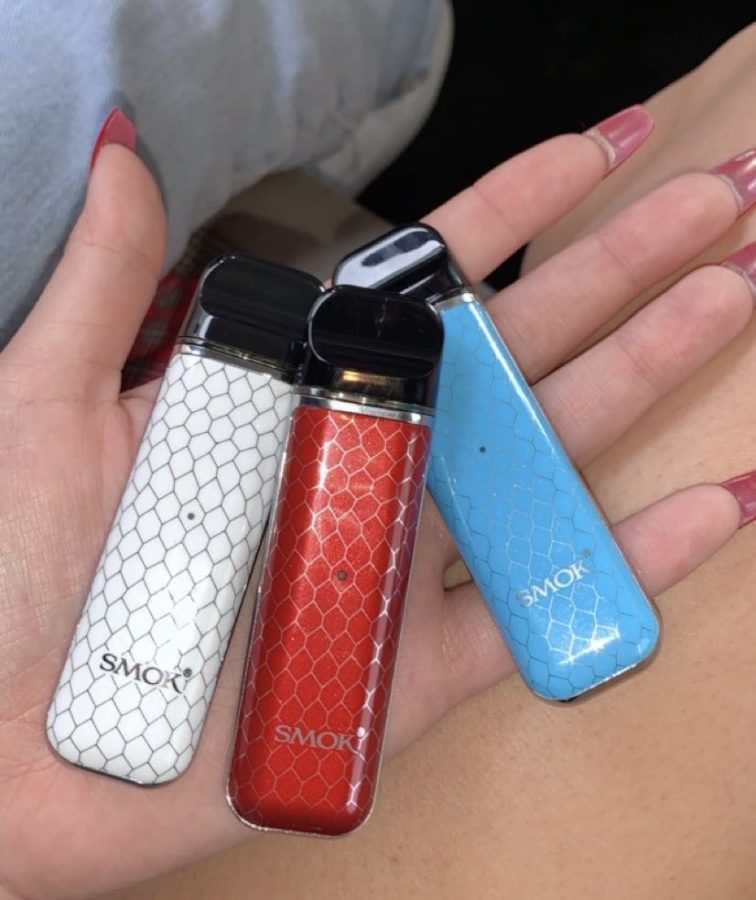Taking a look at the Nicotine “Buzz” Through Students’ Eyes
Photo Courtesy of Anonymous Student
A student displays three Novos (e-cigarettes) which they have come to carry with them almost everywhere they go.
In recent years, news of the vaping epidemic among teenagers has plastered headlines across platforms. Despite the seemingly endless articles about the unknown dangers of e-cigarettes, The National Institute on Drug Abuse reports that 45.6% of 12th graders, 41% of 10th graders and 24.3% of eighth graders have tried some form of vaping as of 2019.
Despite numerous Food and Drug Administration regulations, including an age minimum of 18 to purchase tobacco products and the discontinuation of Juul’s popular flavored pods, teens have sought out alternative sources for their craved nicotine buzz, commonly referred to as a “dome.”
“E-cigarettes are pretty popular [at Portola]. Even the most unexpected people use them, which is really surprising, but at the same time it’s high school,” junior Andrew Tran said. “People want to act cool and try new things, so curiosity is definitely a big part of it.”
For Alyssa*, vaping became a large part of her freshman year routine when hanging out with her friends.
“Nicotine is definitely a social thing because [the e-cigarette] goes around, and it’s something everyone just hits,” Alyssa* said. “You feel like you’re not actually doing it a lot, but when you take a step back, you see that once every Friday turns into every time you hang out, and that turns into an addiction, which is when you start craving it and buying it yourself.”
The continuous release of appealing new fruity flavors such as “banana ice” perpetuates the addiction of curious teenagers who first become hooked on icy throat hits and then grow desperate to fulfill their mind-consuming nicotine cravings. The recent popularization of disposable e-cigarettes has especially made it easier for teenagers to covertly smoke.
Many students are aware of the consequences of vaping, but, according to junior Ian Aros, because of “how trendy it is and [the fact that] the effects are long-term and don’t come as fast as other health issues, people have a hard time fully understanding the harm.”
For students who want to quit, fear prevents many from reaching out for help.
“In this society, we look down on people who use [nicotine] instead of empathizing with them, which just creates fear and embarrassment,” senior Joe*, who has attempted to quit nicotine a few times with varying results, said. “Administration doesn’t really know how to support us in the ways we need to. A lot of the times when we seek out help we end up getting judged and don’t receive the resources we need which is why so many people are still addicted and vaping on campus.”
*Names of students have been changed to maintain anonymity.
Your donation will support the student journalists of Portola High School. Your contribution will allow us to purchase equipment and cover our annual website hosting costs.

Ariana Wu is a member of the Portola Pilot social media team and business team for her second year on the Portola Pilot. Aside from being on the pilot,...





Gwynn | Feb 20, 2020 at 8:06 am
A little disappointed that you claim to be empathetic to nicotine-addicted students, yet your article is full of scare-mongering terms. Making someone feel that their mind is “consumed” by nicotine will probably only make them feel worse about their condition.
Other than that, I am grateful for the statistics at the beginning of the article! 1 in 4 eighth graders is a scary number indeed …